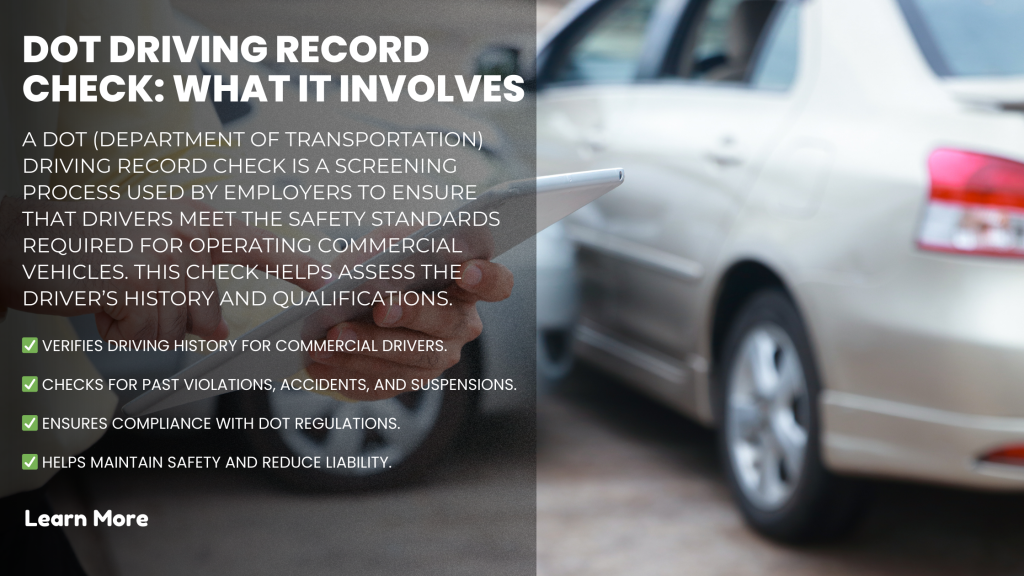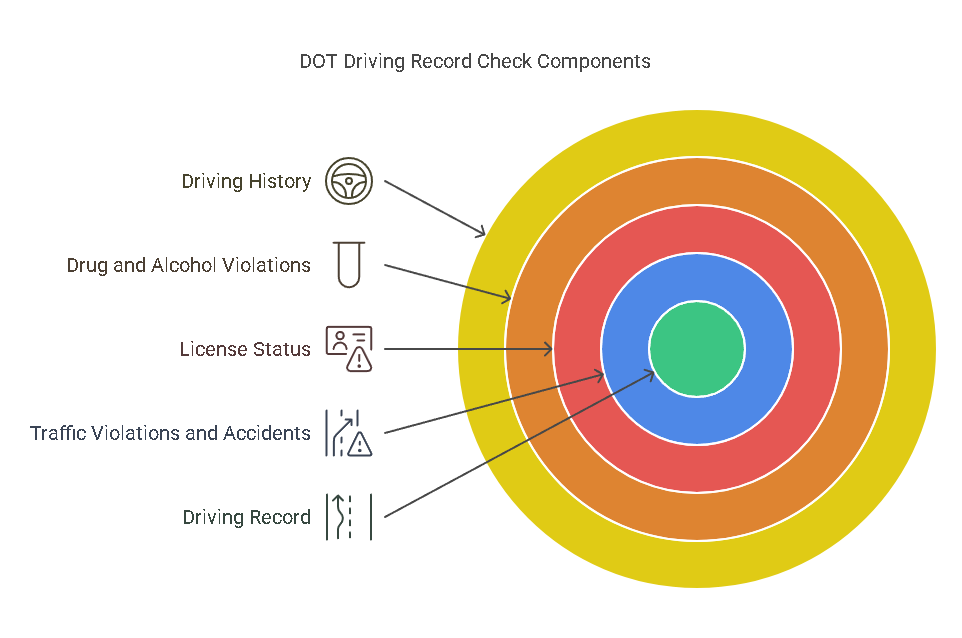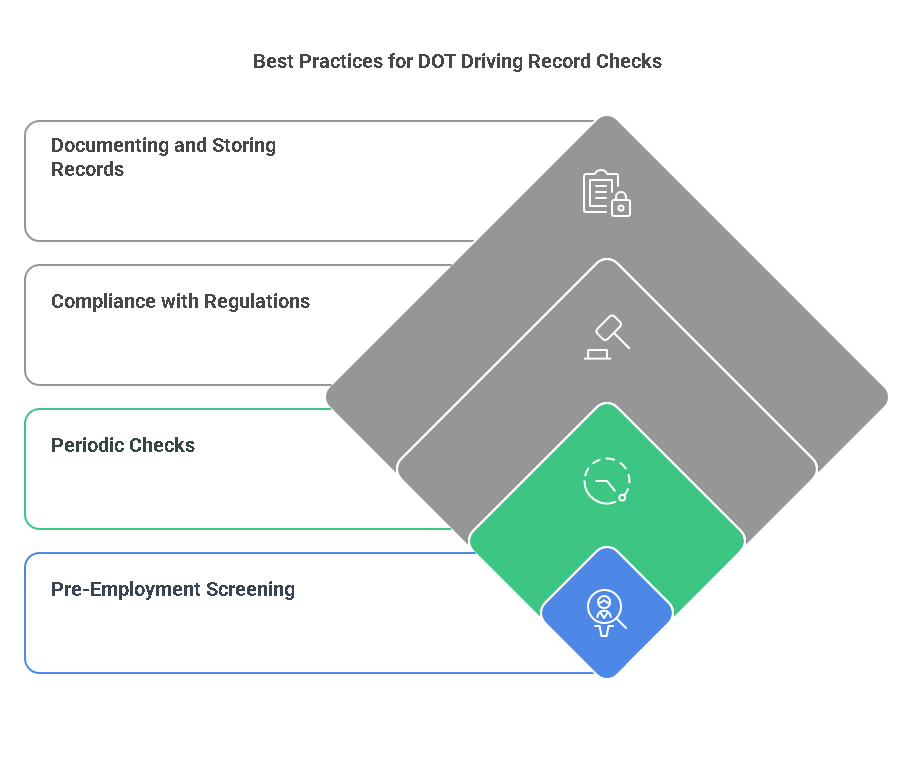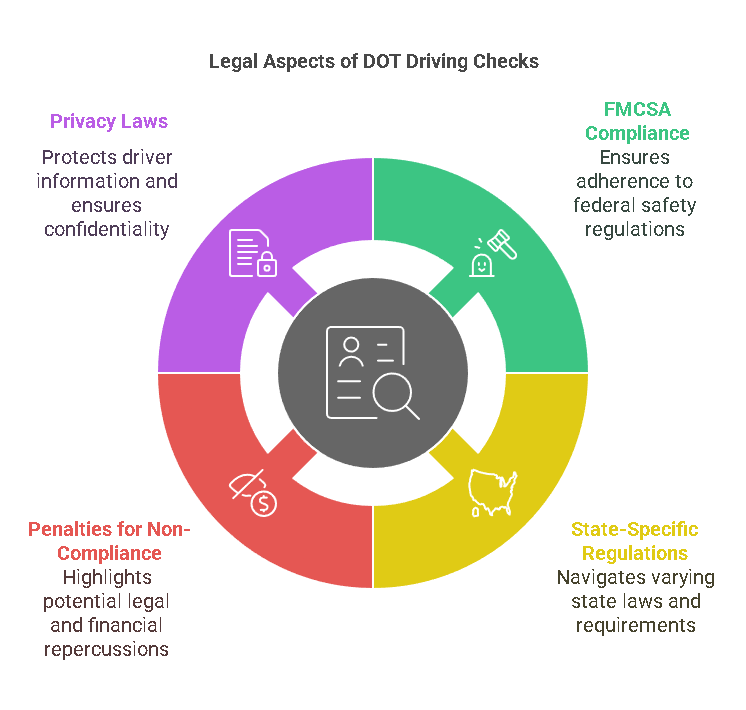Why DOT Driving Record Checks are Essential for Safe and Compliant Hiring

DOT Driving Record Check: Importance, Process, and Best Practices
A DOT driving record check is a comprehensive background check that evaluates a driver’s history on the road. This check, which is mandated by the U.S. Department of Transportation (DOT), is particularly important for those who hold a Commercial Driver’s License (CDL) or operate commercial vehicles. The purpose of this check is to verify the driving history of employees and ensure they comply with safety regulations enforced by Federal Motor Carrier Safety Administration (FMCSA).
These checks are vital for the transportation and logistics industries, where the safety of employees, passengers, and the general public is of utmost importance. DOT checks are designed to minimize the risks associated with driving heavy vehicles, such as trucks, buses, and other large commercial vehicles, which can cause significant damage or harm in the event of accidents. For employers, the DOT driving record check serves not only as a safety measure but also as a means of maintaining legal compliance.
Who Needs a DOT Driving Record Check?
- Commercial Drivers
- Any driver with a Commercial Driver’s License (CDL) is required to undergo a DOT driving record check. CDLs are required for anyone operating large trucks, buses, or vehicles designed to transport hazardous materials. The driving record check ensures that these individuals do not have a history of severe driving violations or safety concerns that could make them a risk on the road.
- The check includes a review of traffic violations, accidents, and other driving-related incidents, which can impact the driver’s ability to safely operate a commercial vehicle.
- Employers in the Transportation Industry
- Employers who hire commercial drivers are required to conduct DOT driving record checks to ensure that their employees meet the qualifications set by the FMCSA. This includes evaluating the history of employees for violations such as driving under the influence (DUI), speeding violations, or accidents.
- DOT checks also help employers verify the validity of the driver’s license and ensure it remains active and free of any restrictions.
- Federal and State Regulations
- Both federal and state regulations mandate DOT driving record checks. The FMCSA sets guidelines for companies to follow when hiring drivers, while individual states may have their own specific regulations. Employers must follow these regulations to avoid legal issues and ensure their drivers are qualified to operate commercial vehicles.
Key Components of a DOT Driving Record Check

A DOT driving record includes various elements that provide insight into the driver’s history. The main components include:
- Traffic Violations and Accidents
- This section details any traffic tickets, citations, or accidents the driver has been involved in. Violations such as speeding, reckless driving, or DUI can significantly affect a driver’s record and their ability to legally drive a commercial vehicle.
- Accidents, especially those resulting in fatalities or significant damage, are also recorded. A history of frequent accidents may indicate a pattern of unsafe driving behavior, which is concerning for employers.
- License Status
- The record will verify the current status of the driver’s license. This includes whether the license is valid, expired, or suspended. Any restrictions placed on the license, such as restrictions on driving certain vehicles or endorsements, will also be noted.
- Drug and Alcohol Violations
- The DOT driving record will include information on any drug or alcohol-related violations. This could include failed drug tests or alcohol screenings that are required for commercial drivers under the DOT regulations. The FMCSA maintains strict policies regarding substance abuse for commercial drivers, and any violations are critical to note.
- Driving History
- The driver’s miles driven and their overall driving history are part of the record. A clean driving history is important for employers to gauge the reliability and safety of the driver. A lack of accidents and violations over time is generally seen as a good indicator of a safe and responsible driver.
Why Are DOT Driving Record Checks Important?
- Ensuring Safety
- The primary purpose of a DOT driving record check is to promote safety on the road. By reviewing the history of a commercial driver, employers can identify any red flags, such as a pattern of reckless driving or previous accidents. This helps prevent unsafe drivers from being hired or continuing to operate vehicles in dangerous conditions.
- With safety violations and accidents being significant causes of accidents in the transportation industry, employers can mitigate the risk of future incidents by screening drivers thoroughly.
- Legal Compliance
- Employers must comply with both state and federal regulations regarding driver qualifications. The FMCSA mandates that all commercial drivers meet specific criteria and pass driving record checks before being hired or continuing to operate commercial vehicles. Failure to follow these regulations can result in hefty fines and even the loss of operating authority for the company.
- For instance, FMCSA regulations require that employers conduct a background check to verify the driver’s employment history, driving record, and compliance with drug and alcohol policies.
- Risk Mitigation
- A DOT driving record check helps employers mitigate legal risks and liability. By ensuring drivers have a clean driving history, employers reduce the chance of future accidents, which could lead to costly lawsuits or damage to the company’s reputation.
- Additionally, conducting regular checks helps to identify any potential risks before they become a problem, allowing the employer to take action to prevent accidents and ensure the safety of both the driver and the general public.
Conducting a DOT driving record check is an essential step for employers in the transportation and logistics industry. By verifying a driver’s history, employers can ensure they comply with federal and state regulations while reducing the risk of hiring unsafe drivers. Here’s a detailed breakdown of how to perform a DOT driving record check.
1. Accessing the Record
There are several ways to access a driver’s DOT driving record. Employers must ensure they obtain the necessary records from reliable sources that comply with the regulations set forth by the FMCSA and state DMV.
- State DMV Requests: Most states require employers to request the driver’s record directly from the Department of Motor Vehicles (DMV). The DMV provides details on a driver’s history, including traffic violations, accidents, and the status of their license.
- Employers must have specific details, including the driver’s full name, driver’s license number, and date of birth.
- Most DMVs allow access to records online through their respective websites or at a local office.
- Online Tools and Services: Many online platforms now offer automated DOT driving record check services, allowing employers to request records quickly. These services are often integrated with other background check systems, providing a comprehensive overview of a driver’s history.
- These platforms provide easy access to records from all 50 states and include traffic violations, accidents, and licensing status.
- Third-Party Services: Employers can also use third-party services like Precisehire to handle DOT driving record checks. These services save time by automating the process, ensuring accuracy, and streamlining record retrieval for employers. By using a third-party provider, companies can be sure that the checks comply with FMCSA and state regulations.
2. Requesting from the State DMV
Requesting a DOT driving record check through the state DMV requires employers to fill out specific forms and provide driver information. The following steps outline the process:
- Visit the State DMV Website: Start by navigating to the appropriate state’s DMV website. Many states offer online portals where employers can request driving records directly.
- Submit the Request: Complete the required forms and provide details such as the driver’s full name, address, license number, and date of birth. Some states may require proof of authorization from the driver before releasing the records.
- Pay the Fee: There may be a nominal fee associated with obtaining the driver’s record. This varies depending on the state.
- Wait for Processing: Depending on the state, processing times can vary. Most states offer expedited services for a higher fee.
- Review the Record: Once you receive the driving record, review it thoroughly for violations, accidents, and the current status of the driver’s license.
3. Using Online Access
In today’s digital world, many employers opt for online services that provide quick access to DOT driving records. These services typically work by partnering with DMV databases to gather driving histories, allowing employers to easily obtain and review a driver’s history.
- Instant Results: One of the benefits of using online tools is that employers can receive instant access to driving records. This ensures that the hiring or screening process doesn’t experience delays.
- Nationwide Database: Some online platforms give access to nationwide driver records, which is particularly useful for employers hiring drivers from multiple states.
4. Third-Party Services
Employers can choose to outsource DOT driving record checks to third-party providers like Precisehire. These services offer automated solutions for obtaining accurate driving records and verifying compliance with FMCSA and state laws.
- Precisehire’s Role: Precisehire offers a comprehensive suite of services that helps businesses streamline their DOT driving record checks. From conducting background checks to obtaining driving history reports, Precisehire helps employers ensure that their drivers are qualified and compliant with the latest safety regulations.
- Efficiency and Accuracy: By leveraging Precisehire, employers can automate the entire process, reducing human error and ensuring that all necessary documentation is in place. The service is particularly beneficial for companies with large fleets of drivers, as it helps manage and store records efficiently.
- Regulatory Compliance: Precisehire also provides support in ensuring compliance with federal regulations, such as FMCSA rules regarding driver qualifications, drug and alcohol testing, and license verification.
Best Practices for Employers Conducting DOT Driving Record Checks

To ensure compliance with FMCSA regulations and to mitigate potential risks, employers should adopt the following best practices when conducting DOT driving record checks.
1. Pre-Employment Screening
Before hiring any commercial driver, employers should conduct a pre-employment DOT driving record check. This helps ensure that the driver does not have a history of violations, accidents, or other issues that may affect their eligibility to operate a commercial vehicle.
- Thorough Evaluation: Employers should review the driver’s full history, including past accidents and any traffic violations. It is important to look for patterns, such as multiple speeding tickets or DUI charges, which may indicate unsafe driving practices.
- Verify Licensing Status: Ensure that the driver’s CDL is valid and free of restrictions that could impact their ability to operate the vehicle.
2. Periodic Checks
While pre-employment checks are essential, employers should also conduct periodic checks on their drivers throughout their employment. These checks help to ensure that the driver’s record remains clean and that they are compliant with FMCSA regulations.
- Regular Monitoring: Schedule regular intervals for conducting checks, such as every six months or annually, depending on the company’s risk management policies.
- Ongoing Compliance: By conducting periodic checks, employers can ensure ongoing compliance with FMCSA guidelines and catch any issues early, before they become problematic.
3. Compliance with Regulations
Employers must ensure that their DOT driving record check process adheres to the FMCSA and state-specific regulations. This involves maintaining a consistent approach to record-keeping and ensuring that all required documents are up-to-date.
- FMCSA Guidelines: Follow the specific guidelines set forth by the FMCSA, such as obtaining a 3-year driving history for all CDL drivers. Employers should also ensure that drivers meet the medical certification requirements.
- State Requirements: Different states may have varying requirements for driver qualifications, so employers must familiarize themselves with these rules to ensure full compliance.
4. Documenting and Storing Records
Properly documenting and storing DOT driving records is critical for both legal and compliance reasons. Employers should implement systems to store records securely and access them when needed.
- Electronic Storage: Use digital tools to store and organize records. Ensure that the system complies with federal and state laws concerning data security and privacy.
- Retention Period: Keep records for the required retention period (usually 3 years for FMCSA compliance). This is essential for auditing purposes and for verifying driver eligibility during the hiring or review process.
| Element | Details |
|---|---|
| Driver’s Name | Full name of the driver. |
| License Number | Unique commercial driver’s license number. |
| Traffic Violations | List of any violations, such as speeding, DUI, or reckless driving. |
| Accidents | Information on accidents the driver has been involved in. |
| License Status | Current status of the driver’s CDL (valid, suspended, expired, etc.). |
| Drug & Alcohol Violations | Record of any violations regarding drug or alcohol testing. |
| Driving History | Total miles driven, including any previous driving experience, and other relevant driving data. |
Precisehire’s Role in DOT Driving Record Checks
As businesses seek more efficient ways to handle DOT driving record checks, Precisehire offers an automated, user-friendly solution that ensures compliance and saves time.
- Automated Solutions: Precisehire allows employers to quickly and accurately request and retrieve DOT driving records, streamlining the process of hiring and screening commercial drivers.
- Compliance Assurance: By using Precisehire, employers can rest assured that their drivers’ records are being properly reviewed, ensuring they are in compliance with the latest FMCSA guidelines.
- Time and Cost Efficiency: Rather than dealing with manual processes and long wait times, Precisehire automates the record-checking process, enabling companies to complete checks faster and more accurately.

